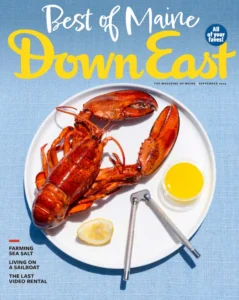
By Joel Crabtree
From our May 2022 issue
Donald Ashmall remembers vividly a blue-sky Sunday morning in the early ’90s, driving with his wife down the hill into Prospect Harbor, where the road jigs right then swings left along the water. In front of them, a truck peeled out of the Stinson Seafood canning factory so fast that the contents of 55-gallon drums packed into its open bed sloshed over the side. The whole width of the pavement, Ashmall realized, was covered in a sludge of unused fish bits. He slowed enough so at least his tires didn’t splatter the foul-smelling muck against the undercarriage, and then, as if conjured, a horde of seagulls instantaneously descended on the spot. Passing by again a few hours later, Ashmall recalls, it looked as if nothing had happened, so thorough were the birds, although he had a funny idea that at least one other person could corroborate the story.
“The Stinson Man bore witness too,” says Ashmall, a pastor who was then new to Prospect Harbor, a village within the down east town of Gouldsboro, and who now serves as president of the Gouldsboro Historical Society. “That sort of endeared the Stinson Man to us.” Also known as Big Jim, the Bunyan-esque fisherman, painted on a 40-foot-tall metal cutout, sports a yellow slicker and matching pants tucked into rubber boots. Over the course of several decades planted to that spot, by the bend in the road, he has become a piece of local history and a familiar face on residents’ daily commutes.
Late last year, American Aquafarms announced it would buy the property on which Big Jim stands, to build a salmon farm just offshore (the project is currently in limbo). The potential arrival of aquaculture sparked a heated local debate, particularly drawing the ire of lobstermen worried about impacts on fishing. Ashmall had another concern: What would become of Big Jim?
Big Jim isn’t originally from Prospect Harbor. He first perched on the side of Route 1, just across the state line from New Hampshire. The Maine Sardine Council put him there, and he held between his hands a disproportionately large (even in relative terms) tin of sardines that welcomed travelers to “Vacationland & Sardineland.” Back then, sardines supplied a booming industry — some 50 canneries lined the coast, mostly down east. By the ’80s, though, canning was in decline, owing to competition from abroad, corporate consolidation, and changing domestic tastes. The Sardine Council decided to retire Big Jim.
The Stinson family, which owned a still-operating cannery in Prospect Harbor, offered to save the council the considerable cost of disposal, and put Big Jim on the back of a truck headed up the coast. A fresh paint job changed the label on the sardine tin to the Stinson brand (and turned the formerly chiseled Hollywood jawline somewhat doughy). When, in 2010, the cannery closed and became a lobster-packing facility, a lobster trap replaced the sardine tin, and so Big Jim marked one of the tectonic shifts in Maine fisheries. He might soon mark another.

a lobsterman. Photo by Brett Binns
Earlier this year, Ashmall and other members of the historical society met with American Aquaculture representatives to discuss Big Jim’s future. Those representatives said they’re planning to keep Jim where he is and hoping to give him a sprucing up — a preliminary drawing from the company shows him holding not a sardine tin or a lobster trap but a basket full of farm-raised salmon. “The maritime history of this town and its identity as a town are just inextricably intertwined,” Ashmall says. “It really doesn’t matter what he’s holding as much as it matters that he’s there and is representing the maritime interests of the town.”
Peter Colson, who worked as a manager at the plant in both its sardine and lobster days, was greeted by Big Jim on his way to work every day. He came to see in the towering figure a certain steadfastness and resiliency, a fitting ambassador for the small community. “When you come around that corner by the factory,” he says, “Big Jim’s still standing.”



